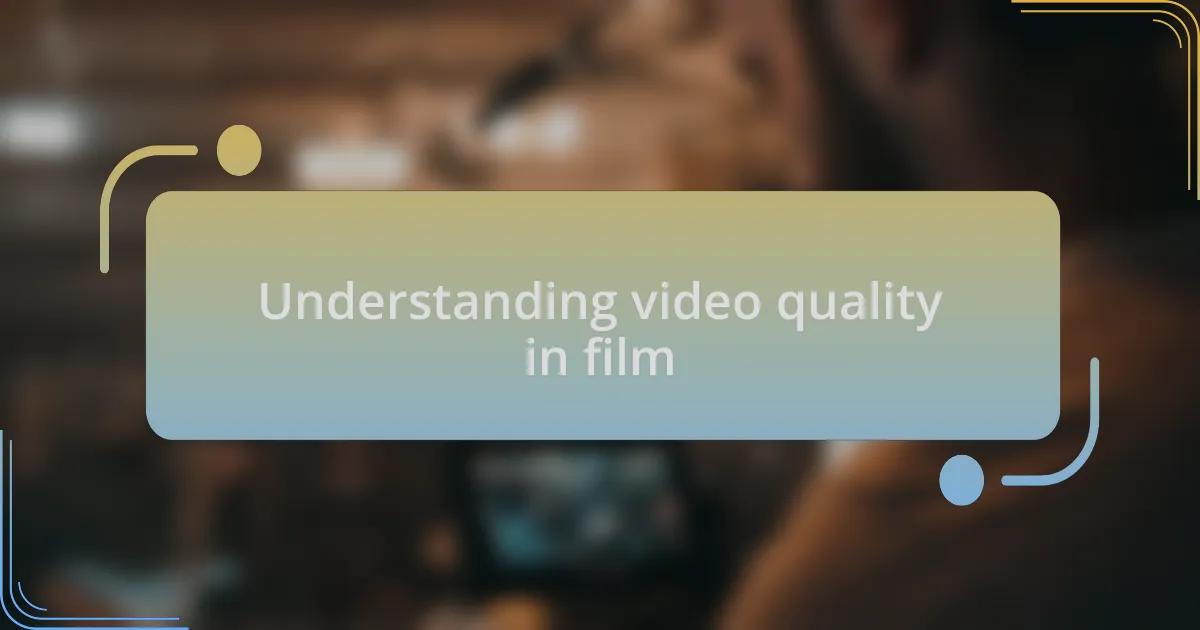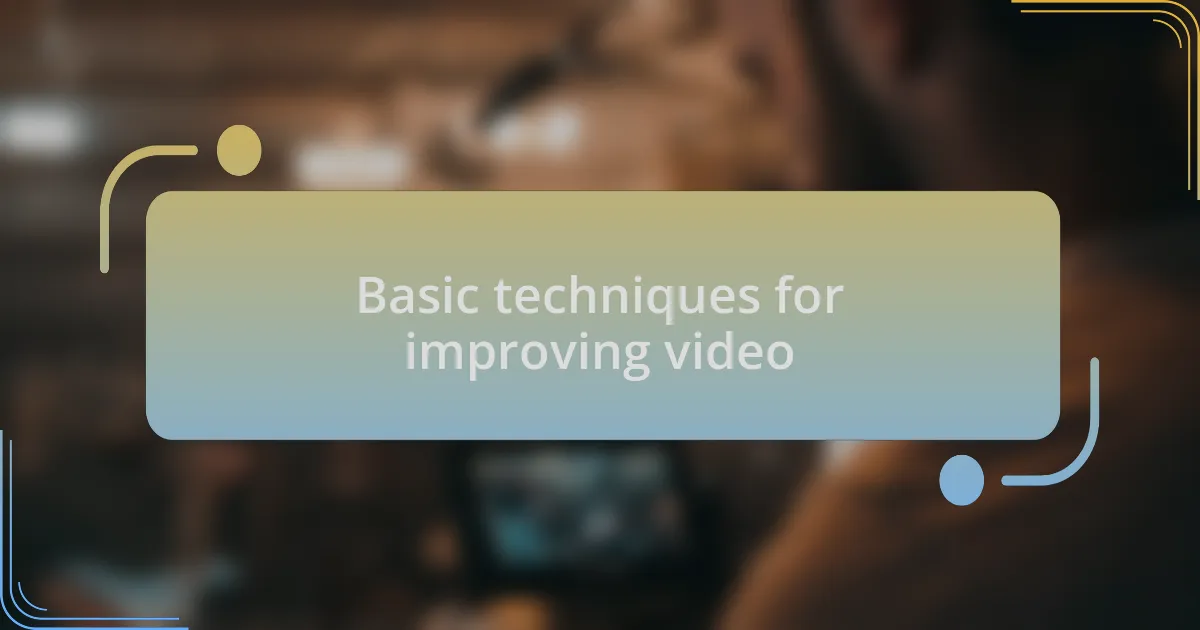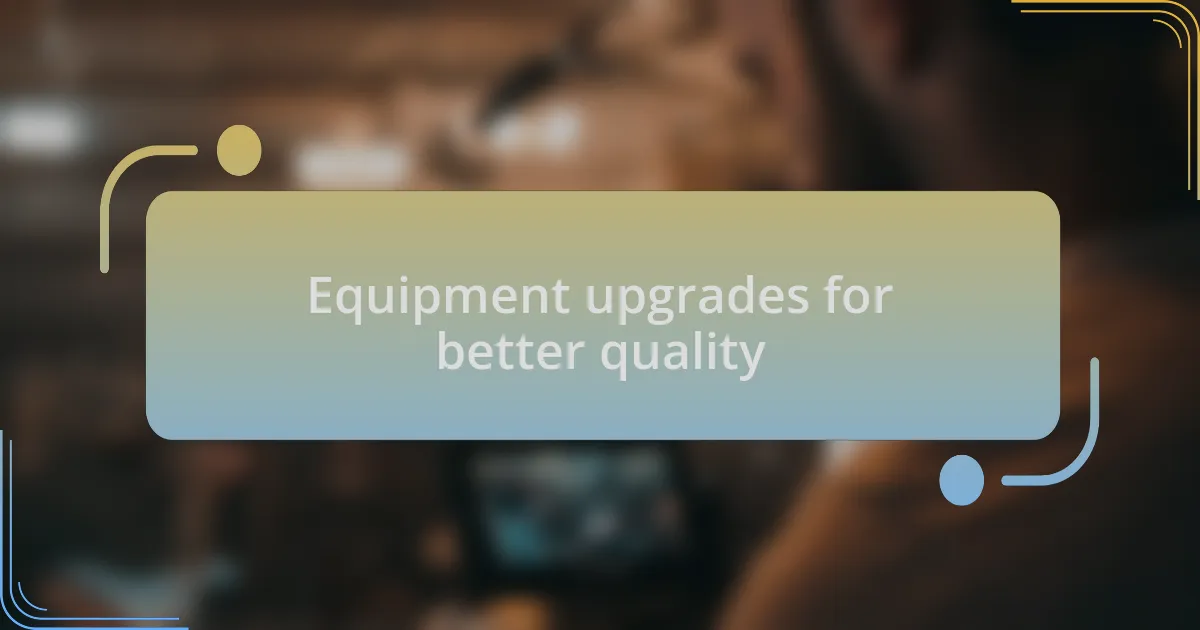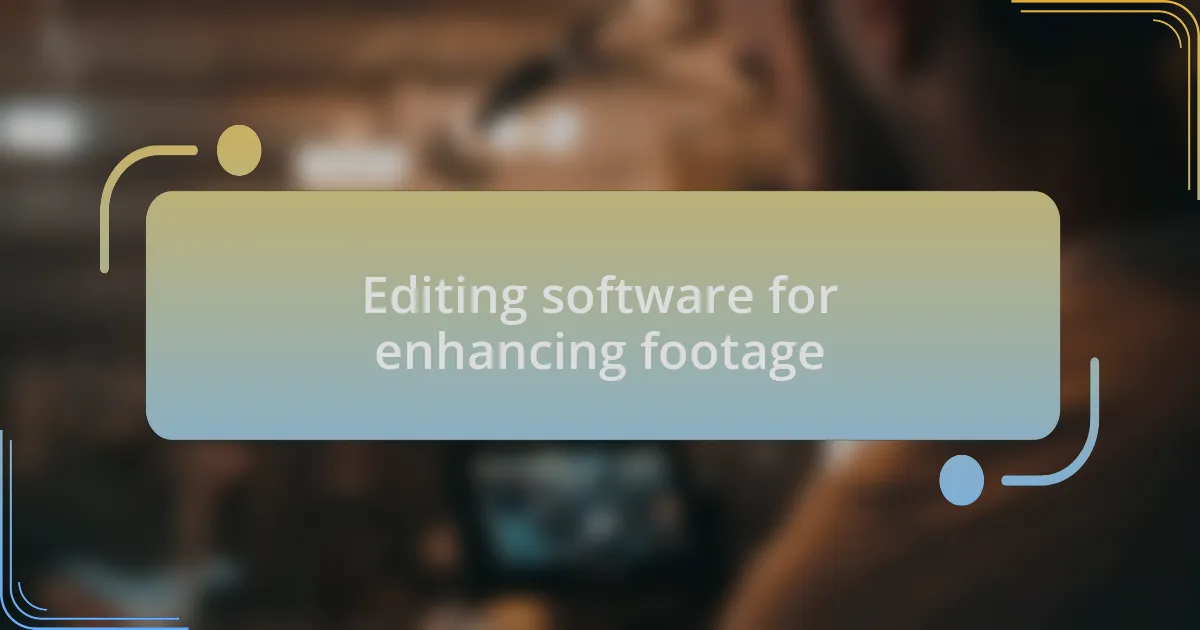Key takeaways:
- Video quality encompasses resolution, frame rate, color grading, and the emotional connection created through visual storytelling.
- Effective use of natural light and proper composition significantly enhance video mood and clarity.
- Upgrading equipment, particularly lenses and stabilizers, plays a crucial role in achieving professional-looking videos.
- Editing software can transform footage, allowing for creative expression through color grading and effects, elevating the overall narrative experience.

Understanding video quality in film
Understanding video quality in film goes beyond just the resolution; it’s about how each element contributes to the overall storytelling experience. For me, the first time I really noticed this was during a film screening where the subtle interplay of light and shadow created a mood that stayed with me long after the credits rolled. Can you recall a moment in a film where the visual quality just pulled you in?
Resolution, frame rate, and color grading are crucial components that define video quality. I remember experimenting with different settings on my camera, and it was a revelation to see how a slight adjustment in color can evoke entirely different emotions. Have you ever thought about how a scene’s color palette enhances your connection to the characters?
When I began acquiring better lenses, it was like opening a new dimension of possibilities. Suddenly, the sharpness, bokeh, and even the depth of field of a shot made every frame feel like an artwork. It made me realize that investing in quality gear isn’t just a technical choice; it’s an artistic one that transforms ordinary visuals into captivating narratives.

Basic techniques for improving video
One of the simplest techniques I discovered early on was to harness natural light effectively. I remember filming a scene outdoors at golden hour, when the sunlight was soft and warm. It turned what could have been an average shot into something magical. Have you ever noticed how the right lighting can completely change the mood of a scene?
Another basic yet powerful technique is utilizing proper composition. When I began focusing on the rule of thirds, it transformed how I framed my shots. I recall one particular project where adjusting my angles made the visuals not just more interesting but also clearer in telling the story. It made me wonder: are we really paying enough attention to how we position our subjects in a frame?
Audio quality is often overlooked, but in my experience, clear sound can elevate a video dramatically. I once filmed a documentary where we recorded interviews in a noisy environment. Later, I regretted not using better microphones because the ambient noise overshadowed powerful stories. It serves as a reminder that good video isn’t just about visuals; it’s about the whole sensory experience. How have you ensured your sound quality matches the stunning visuals you’ve captured?

Equipment upgrades for better quality
Upgrading equipment can make a significant difference in the overall quality of your videos. I remember when I transitioned from a basic DSLR to a mirrorless camera. The clarity and dynamic range were astounding. Suddenly, my videos had that professional touch that I had been striving for—what a rewarding experience! Have you ever felt the thrill of capturing an image that looks almost lifelike?
In my journey, investing in lenses proved to be just as important as the camera itself. I once decided to purchase a prime lens, and the sharpness it brought to my shots was breathtaking. It allowed me to create a beautiful bokeh effect that drew attention to the subject while softening the background. This made me realize how often we overlook the significance of choosing the right lens to tell our stories visually. How have your lens choices impacted your narrative?
Tripods and stabilizers also play a crucial role in enhancing video quality by ensuring steady shots. I remember a shoot where shaky footage nearly ruined the whole scene. After I invested in a gimbal stabilizer, my subsequent projects felt much smoother and professional. It’s easy to underestimate the importance of stability until you see the difference in the final cut. Isn’t it fascinating how the right tools can elevate a vision into high-quality reality?

Editing software for enhancing footage
Editing software can truly elevate your footage, bringing your creative vision to life in unexpected ways. I remember when I first began using Adobe Premiere Pro. The intuitive interface made it easy to navigate, and the color grading tools allowed me to transform dull footage into a visually stunning masterpiece. Have you ever felt a rush of excitement when you see your raw clips take on new life through editing?
I also experimented with DaVinci Resolve, known for its powerful color correction capabilities. I recall spending hours fine-tuning the hues in one of my short films. The result was a vibrant look that perfectly matched the mood I wanted to convey. It’s remarkable how the right software can allow your unique style to shine through. How do you think color plays a role in storytelling?
Incorporating effects and transitions can enhance your narrative, too. The first time I used motion graphics in my videos, I was blown away by how they added a layer of professionalism and flair. It made me realize that editing is not just about cutting clips together; it’s about crafting an engaging experience for the viewer. Have you explored any advanced features that pushed your editing skills further?

Lessons learned through my experience
Throughout my journey in film production, I’ve learned that understanding lighting is crucial for improving video quality. I vividly remember shooting a scene outdoors one golden hour, and it felt like magic. The warm, soft light enhanced every detail, making the footage sparkle. Have you ever captured a moment where the light transformed everything? It taught me that planning for the right lighting can change the entire mood of a project.
Another significant lesson was the importance of sound design, which I initially underestimated. I recall a project where I struggled with audio quality. Investing time in sound editing not only helped in elevating the visuals but also emotionally connected my audience to the story. It made me realize that viewers often feel the emotion of a scene through sound as much as through visuals. Isn’t it fascinating how sound can amplify what’s happening on screen?
Lastly, collaboration has been a game changer for me. I remember inviting a fellow filmmaker to co-edit one of my films. Their fresh perspective brought out elements in my footage that I hadn’t noticed before. This experience underscored the idea that two heads are often better than one. Have such collaborative moments enriched your projects too? It’s invaluable to learn from others and recognize that teamwork can lead to incredible results.